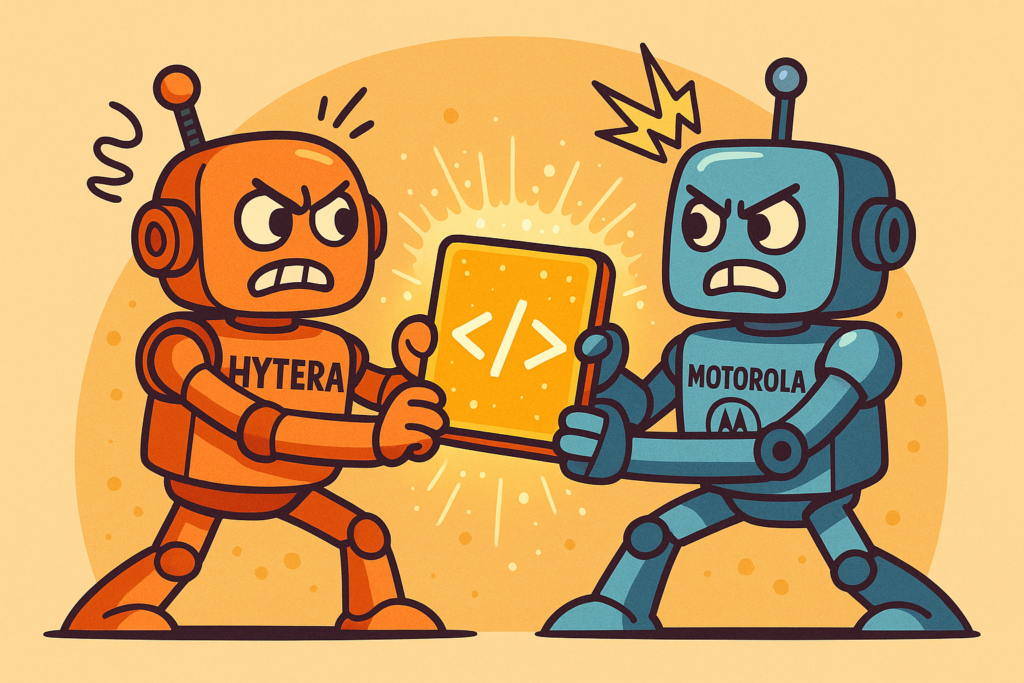Robot Rumble: Motorola and Hytera Throw Down Over Code

It wasn’t exactly Rock ’Em Sock ’Em Robots, but the recent battle between Motorola Solutions and Hytera Communications was certainly a copyright and tech-world punch-up — with real ramifications for copyright law relating to software.
Motorola accused Hytera of pinching thousands of confidential documents and source code files — the digital DNA of Motorola’s radio communications tech — and using them to turbocharge Hytera’s own products.
The claim was that three Motorola engineers downloaded a treasure trove of materials from their work accounts before hopping over to Hytera in 2008. Motorola was not amused, and sued in both the US and Australia, claiming copyright infringement, trade secret theft, and that it’s just not cricket.
Here’s how it unfolded:
| Year | Event |
|---|---|
| 2007–2008 | Three Motorola engineers leave, allegedly taking source code and confidential documents. |
| 2010s | Hytera launches eerily similar digital mobile radios (DMRs) into the market. |
| 2017 | Motorola sues Hytera in the US (for trade secret theft and copyright infringement). |
| 2020 | A US jury awards Motorola nearly US$765 million. |
| 2024 | The US Seventh Circuit Court of Appeals cuts down the damages, ruling copyright law doesn’t stretch to overseas sales. |
| 2022–2024 | In Australian proceedings, Motorola wins a Federal Court case finding substantial copying of its software and some patent infringements. |
In Australia (Hytera Communications Corporation Ltd v Motorola Solutions Inc [2024] FCAFC 168), the Federal Court was having none of Hytera’s various arguments. It found that Hytera’s software infringed Motorola’s copyrights in six major works and awarded Motorola remedies accordingly. One of Motorola’s patents was also found infringed — though another was knocked out for invalidity.
So, why does this matter for copyright and software?
First up: software source code is absolutely protected by copyright. Nothing has changed there.
It doesn’t matter if the copying happened sneakily, through engineers quietly/brazenly exporting files out the back door. If your new product looks suspiciously like the old employer’s, and the code similarities are undeniable, you’re probably in trouble.
It’s a breach of copyright in a copyright work to copy all or a substantial part of the copyright work without permission. What this case does is clarify what “substantial part” means when it comes to software.
Generally, in copyright, the test for whether the copied bit was a “substantial part” of the copyright work is a “qualitative test” – that is, it’s about quality, not quantity.
In a music context, cases such as the famous “Men At Work” case (EMI Songs v Larrikin Music) taught us that it’s how important the copied musical passage was to the whole work and not how lengthy it was (that quirky flute part in “Land Down Under” was held to be a reproduction of an important, but short, part of the melody in “Kookaburra Sits in the Old Gum Tree”).
The Court in that case said substantiality depends mainly on the importance or distinctiveness of the part copied in relation to the original work — even a small musical phrase, if distinctive, could be substantial.
In Hytera, though, the Court made an important distinction. When it comes to software, it’s not about how functionally important the copied code is. You could copy a piece of code that barely moves the dial commercially — and still infringe. The real test is whether the copied part contains the original intellectual effort and creative expression of the coder.
It’s a subtle shift from cases like Men at Work, where the Court focused on whether the snippet (a melody, in that case) was distinctive or significant to the work overall.
In software land, copyright doesn’t care how useful the copied bit is — it only cares if it was original.
The Court in Hytera, though, was careful when discussing “intellectual effort” not to revert entirely back to the old “sweat of the brow” arguments.
In the old Desktop Marketing Systems v Telstra case (early Federal Court levels) it was held that just collecting and compiling basic data was enough for copyright to apply, because it involved effort to compile it all together – that is, it involved “sweat of the brow.”
But then IceTV v Nine (2009) came along, in which the High Court said No — effort alone is not enough. It was held that copyright protects original expression — meaning something resulting from independent intellectual effort and some creative choice, not just labour.
In Hytera, the Court was very careful not to slip all the way back into pure “sweat of the brow” thinking – the Court didn’t say that simply writing code or working hard gave rise to copyright protection. Instead, they said:
-
The copied source code was protected because it reflected original intellectual effort and creative choices — not just functional output.
-
You still need some degree of creative expression — but in software, that creativity can sit in how the code is written, how problems are solved, and the structure of the program — not necessarily in the “importance” of the function itself.
In other words:
-
Not just “I worked hard, therefore copyright.”
-
But “I made creative and original choices, therefore copyright — even if the code serves a functional purpose.”
Copyright Lessons from Hytera
-
Don’t steal code. Seriously. Just don’t – it leaves digital fingerprints everywhere.
-
Copyright protects software structure and content, not just fancy graphics or user interfaces.
- Judges don’t love “but we changed it a bit” arguments when the starting point was a pile of stolen files.
High Court Appeal?
In early April, Hytera applied to the High Court for special leave to appeal, but in an extra blow to Hytera’s already deflated spirits, the High Court refused to grant leave as their appeal “does not enjoy sufficient prospects of success to warrant the grant of special leave”. Ouch …